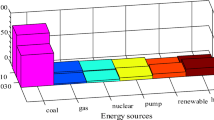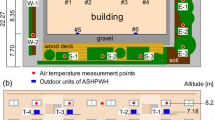Abstract
Air source heat pump systems must operate efficiently during the winter to ensure that energy-saving targets are met and occupants of residential and commercial buildings have acceptable thermal comfort. Investigation on the behavior of air source heat pump systems based on the analysis of real data is important to improve the system performance and attain optimum performance during winter. This will assist governments and industry sectors in formulating energy policies and improving this technology efficiently. Currently, there is no available studies relating the use of data-driven models for improving air source heat pump system. Thus, a large experimental dataset was obtained from four real projects in Bei**g, and a hybrid and general model (ambient temperature –20 °C to + 17 °C) coupling various data-driven models was established. A methodology was developed to assess and detect outliers in the dataset that cause incorrect results for the developed model. After removing the outliers, a regression analysis revealed an excellent agreement between almost 8000 experimental data samples and the predictions, with a coefficient of determination of 0.87. Two scenarios were considered for improving and optimizing the thermal performance of air source heat pump systems using the developed predictive model. A growth of 8.18% was observed in the coefficient of performance compared with that of the real operation when the indoor temperature was 18–20 °C. The total system performance increased by an average of 15.93% when the indoor temperature was set between 18 and 20 °C and the rated capacity increased from 11.5 to 12 kW.



source heat pump systems
















Similar content being viewed by others
References
Zheng W, Zhang Y, **a J, Jiang Y. Cleaner heating in Northern China: potentials and regional balances. Resour Conserv Recycl. 2020;160:104897.
Wang X, **a L, Bales C, Zhang X, Copertaro B, Pan S, Wu J. A systematic review of recent air source heat pump (ASHP) systems assisted by solar thermal, photovoltaic and photovoltaic/thermal sources. Renew Energy. 2020;146:2472–87.
Wang Z, Li G, Wang F, Li K, Lou Y. Techno-economic evaluation of a frost-free air source heat pump water heater. Sustain Cities Soc. 2020;57:102102.
Wang W, Cui Y, Sun Y, Deng S, Wu X, Liang S. A new performance index for constant speed air-source heat pumps based on the nominal output heating capacity and a related modeling study. Energy Build. 2019;184:205–15.
Mengjie S, Zhihua W, Ning M, Jiankai D, Haoran Z. Defrosting start control strategy optimization for an air source heat pump unit with the frost accumulation and melted frost downwards flowing considered. Sustain Cities Soc. 2019;46:101461.
Zheng X, Shi R, You S, Han Y, Shi K. Experimental study of defrosting control method based on image processing T technology for air source heat pumps. Sustain Cities Soc. 2019;51:101667.
Tangwe S, Simon M, Edson LM, et al. Performance optimization of an air source heat pump water heater using mathematical modelling. J Energy South Afr. 2017;26(1):96–105.
Shi WX, Pan LS. Experiment study on performance of air source heat pump. Adv Mater Res. 2013;805:645–8.
Maleki A, Elahi M, Assad MEH, et al. Thermal conductivity modeling of nanofluids with ZnO particles by using approaches based on artificial neural network and MARS. J Therm Anal Calorim. 2020;20:1–12.
Shadloo MS, Rahmat A, Karimipour A, Wongwises S. Estimation of pressure drop of two-phase flow in horizontal long pipes using artificial neural networks. ASME J Energy Resour Technol. 2020;142(11):112110.
Dhahri M, Nekoonam S, Hana A, et al. Thermal performance modeling of modified absorber wall of solar chimney-shaped channels system for building ventilation. J Therm Anal Calorim. 2020;32:1–13.
Esen H, Inalli M, Sengur A, Esen M. Performance prediction of a ground-coupled heat pump system using artificial neural networks. Expert Syst Appl. 2008;35:1940–8.
Esen H, Inalli M. Modelling of a vertical ground coupled heat pump sys- tem by using artificial neural networks. Expert Syst Appl. 2009;36:10229–38.
Esen H, Esen M, Ozsolak O. Modelling and experimental performance analysis of solar-assisted ground source heat pump system. J Exp Theor Artif Intell. 2017;29:1–17.
Bacthler H, Browne MW, Bansal PK, Kecman V. Neural networks—a new approach to model vapour compression heat pumps. Int J Energy Res. 2001;25:591–259.
Yin X, Cao F, Wang J, Li M, Wang X. Investigations on optimal discharge pressure in CO2 heat pumps using the GMDH and PSO-BP type neural network—part a: theoretical modeling. Int J Refrigeration. 2019;106:549–57.
Gramatica P. Principles of QSAR models validation: internal and external. QSAR Comb Sci. 2007;26:694–701.
Rousseeuw PJ, Leroy AM. Robust regression and outlier detection. New York: Wiley; 2005.
Zendehboudi A, Saidur R. A reliable model to estimate the effective thermal conductivity of nanofluids. Heat Mass Transf. 2019;55:397–411.
Majidi SMJ, Shokrollahi A, Arabloo M, Mahdikhani-Soleymanloo R, Masihi M. Evolving an accurate model based on machine learning approach for prediction of dew-point pressure in gas condensate reservoirs. Chem Eng Res Des. 2014;92:891–902.
Zendehboudi A, Tatar A, Li X. A comparative study and prediction of the liquid desiccant dehumidifiers using intelligent models. Renew Energy. 2017;114:1023–35.
Shokrollahi A, Tatar A, Safari H. On accurate determination of PVT properties in crude oil systems: committee machine intelligent system modeling approach. J Taiwan Instit Chem Eng. 2015;55:17–26.
Parashar N, Aslfattahi N, Yahya SM, Saidur R. An artificial neural network approach for the prediction of dynamic viscosity of MXene-palm oil nanofluid using experimental data. J Therm Anal Calorim. 2020;25:1–12.
Jang JSR. ANFIS: adaptive-network-based fuzzy inference system. IEEE Trans Syst Man Cybern. 1993;23:665–85.
Ahmadi MH, Ahmadi MA, Nazari MA, Mahian O, Ghasempour R. A proposed model to predict thermal conductivity ratio of Al2O3/EG nanofluid by applying least squares support vector machine (LSSVM) and genetic algorithm as a connectionist approach. J Therm Anal Calorim. 2018;135:271–81.
Baghban A, Habibzadeh S, Ashtiani FZ. Toward a modeling study of thermal conductivity of nanofluids using LSSVM strategy. J Therm Anal Calorim. 2019;135:507–22.
Zendehboudi A, Baseer MA, Saidur R. Application of support vector machine models for forecasting solar and wind energy resources: a review. J Clean Prod. 2018;199:272–85.
Acknowledgements
This research was supported by the National Natural Science Foundation of China (Grant Number 51638010) and the Innovative Research Group of the National Natural Science Foundation of China (Grant Number 51521005).
Author information
Authors and Affiliations
Corresponding author
Additional information
Publisher's Note
Springer Nature remains neutral with regard to jurisdictional claims in published maps and institutional affiliations.
Rights and permissions
About this article
Cite this article
Zendehboudi, A., Zhao, J. & Li, X. Data-driven modeling of residential air source heat pump system for space heating. J Therm Anal Calorim 145, 1863–1876 (2021). https://doi.org/10.1007/s10973-021-10750-1
Received:
Accepted:
Published:
Issue Date:
DOI: https://doi.org/10.1007/s10973-021-10750-1




